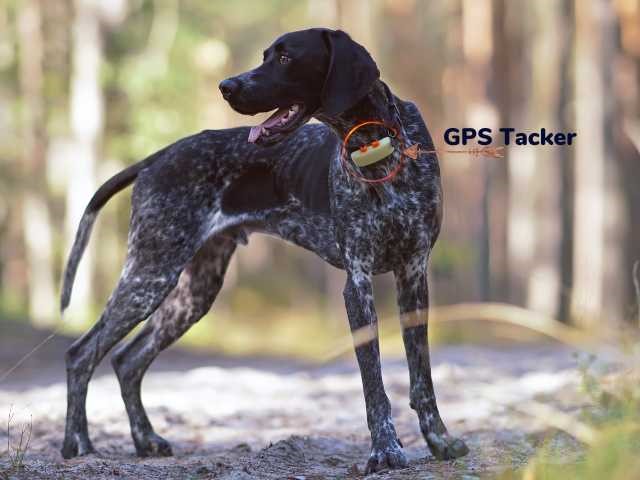Different Types Of Dog Identification Methods
One of the responsibilities of being a parent is making sure a child knows his address and telephone number. Parents patiently remind their children if they ever get lost, they need only find a police officer and tell the officer where they live. A good, permanent, and easily recognized ID — complete with your current address and phone number — is the best way to make sure the four-legged members of your family always find their way home safely, too.
There are three types of identification for dogs who fit this bill: tags, tattoos, and microchips. Each has its advantages and disadvantages, but no one method offers complete protection. Used together, however, they provide the best chance of a happy reunion with a lost dog.Pet Identification (Pet ID) is the most important thing that you could do to keep your pet safe.
When it comes to owning a pet, their safety and well-being are of utmost importance. One essential aspect of responsible pet ownership is ensuring that they have proper identification. Pet ID play a crucial role in reuniting lost pets with their owners and providing vital information in case of emergencies. In this blog post, we will explore the various types of pet IDs available and their significance in safeguarding our beloved furry friends.
Why are pet IDs essential for the well-being and safety of our pets?
Pet IDs are essential for several reasons. Firstly, they serve as a form of identification for our pets, enabling a swift reunion if they become lost or stray. With proper identification, whether through collar tags, microchips, or personalized IDs, anyone who finds a lost pet can easily contact the owner and ensure their safe return. Pet IDs provide peace of mind for pet owners, knowing that their beloved companions have a higher chance of being reunited with them.
Secondly, pet IDs play a crucial role in emergencies. In unforeseen situations where a pet requires urgent medical attention, having identification with important details such as allergies or medical conditions can be life-saving. Veterinarians and animal care professionals can quickly access this information through pet IDs, enabling them to provide the necessary treatment promptly. Pet IDs also ensure that in the event of natural disasters or accidents, authorities can identify and assist pets, keeping them safe during challenging times.
What are the benefits of Pet IDs?
Personalized pet IDs, such as the newly launched personalized collars from Petofy, offer several benefits for pet owners.
Here are some key advantages of personalized pet IDs:
Enhanced Identification
Personalized pet IDs provide a customized and unique identification method for your pet. With a personalized collar, you can have your pet’s name, your contact information, and any additional details you want to include directly embroidered or printed on the collar. This makes it easy for anyone who finds your lost pet to quickly identify them and contact you.
Style and Visual Appeal
Personalized collars add a touch of style and personality to your pet’s appearance. They come in various colors, designs, and materials to suit different preferences. By choosing a personalized collar for your pet, you not only ensure their safety but also make them look fashionable and unique.
Durability and Longevity
Personalized collars are typically made of high-quality materials that are durable and long-lasting. They are designed to withstand the wear and tear of daily activities, ensuring that the identification remains intact and legible over time. This durability eliminates the need for frequent replacement, providing a reliable identification solution for your pet.
Convenience and Ease of Updating
Personalized collars offer the convenience of having your pet’s identification information always with them. Unlike tags that can get lost or damaged, the identification details on a personalized collar are directly incorporated into the collar itself. This eliminates the hassle of constantly attaching and removing tags. Additionally, if any changes occur, such as a new phone number or address, you can easily update the information on the collar without the need for additional accessories.
Increased Security and Peace of Mind
By using personalized pet IDs, you increase the security and peace of mind for both you and your pet. In the event that your pet goes missing, its personalized collar serves as a visible and reliable means of identification. It significantly increases the chances of a quick reunion, as anyone who comes across your pet can readily identify them and contact you using the information displayed on the collar.
Pet IDs can be the savior
Not opting for pet IDs can pose several challenges and disadvantages for both pet owners and their furry companions. Here are a few:
Difficulty in Reuniting Lost Pets
Without proper identification, it becomes incredibly challenging to reunite lost pets with their owners. If a pet wanders off or gets separated, anyone who finds them will have no way of contacting the owner or knowing crucial information about the pet. This significantly decreases the chances of a successful reunion and may result in prolonged separation or even permanent loss.
Limited Information in Emergencies
In emergencies or situations requiring immediate medical attention, the absence of a pet ID can hinder effective treatment. Pet IDs often contain important details such as allergies, medical conditions, or required medications. Without this information readily available, veterinarians may face challenges providing appropriate care, potentially compromising the well-being of the pet.
Dependency on External Factors
Relying solely on external factors, such as a lost pet being brought to an animal shelter or veterinary clinic, can be unreliable. Shelters and clinics might not be the first destination for a concerned citizen who finds a lost pet. Without visible identification, the finder might attempt to take matters into their own hands or unknowingly keep the pet, leading to further complications and difficulty in locating the owner.
Delayed Response Time
When a lost pet is found, the absence of a pet ID increases the time it takes to locate the owner. The finder may need to resort to alternative methods, such as posting flyers or searching online platforms, to try and locate the pet’s owner. This delay can cause unnecessary stress and anxiety for both the owner and the pet, as well as prolong the period of separation.
Limited Access to Additional Information
Pet IDs, especially modern ones like QR code tags, can provide comprehensive information about the pet, including vaccination records, dietary needs, and behavioral information. Not having access to this additional information can hinder pet care professionals or good Samaritans from providing optimal care and support to the pet when needed.
Different Types of Pet IDs
Collar Tags
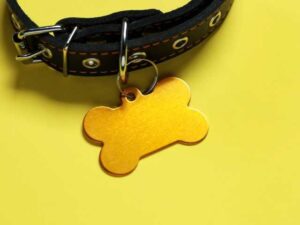
Collar tags are one of the most common forms of pet identification. These small metal or plastic tags are attached to a pet’s collar and typically display the pet’s name, owner’s contact information, and sometimes, additional details like medical conditions or allergies. They are easily visible and provide a quick way for anyone who finds a lost pet to contact the owner.
Pet Microchips
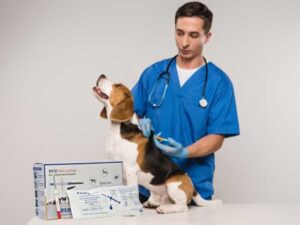
Microchipping is a popular and permanent form of pet identification. A microchip is a tiny electronic device, about the size of a grain of rice, that is implanted under the pet’s skin, usually between the shoulder blades. Each microchip contains a unique identification number linked to the owner’s contact information in a database. When a lost pet is found, a veterinarian or animal shelter can scan the microchip, retrieve the ID number, and contact the owner.
QR Code Tags
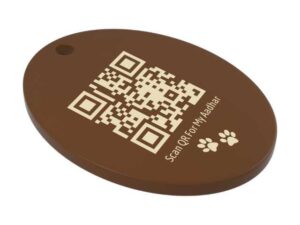
With advancements in technology, QR code tags (Pet Aadhar) have emerged as a modern and convenient method of pet identification. These tags contain a QR code that can be scanned using a smartphone or QR code reader. The code provides instant access to the pet’s profile, which may include the owner’s contact information, medical history, vaccination records, and even a photo of the pet. QR code tags offer a comprehensive and easily updatable way to store vital information about your pet.
GPS Tracking Devices
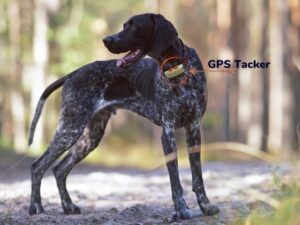
For pet owners concerned about their pets’ whereabouts in real-time, GPS tracking devices offer a reliable solution. These small devices can be attached to the pet’s collar or harness and use GPS technology to track their location. The owner can access the pet’s location through a smartphone app or website, ensuring peace of mind and enabling prompt retrieval if the pet goes missing.
Personalized ID Collars
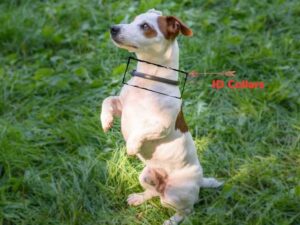
Personalized ID collars are an alternative to traditional collar tags. These collars have the pet’s identification information directly embroidered or printed onto the collar itself. They eliminate the need for additional tags that can be noisy or easily lost. Personalized ID collars are durable and stylish, and provide a permanent form of identification for your pet.
Collar tag
Include your name and multiple phone numbers, such as home, cell and office, to make it easier to be contacted.
Pros:
- Easy to acquire
- Inexpensive
Cons:
- Collars may be snagged on things, pulled off and lost
- Pet thieves can easily remove a collar
Microchip
Before purchasing and having this rice-grain size chip implanted under your dog’s skin, make sure local animal shelters and animal welfare agencies have a compatible scanner to detect and read that microchip brand.
Pros:
- No batteries, maintenance or monitoring
- Implanting chip doesn’t require anesthesia
Cons:
- Can trigger infection at implantation site
- Doesn’t deter pet theft because chips aren’t visible
Tattoo
Placed under the ear, belly or inner thigh, your pet’s tattoo should be registered with your vet or the specialist who applied it.
Pros:
- Tattoos are visible, so anyone finding the animal knows it’s someone’s pet
- Pet thieves are less likely to steal tattooed pets because many regions impose fines or jail time for theft of tattooed pets
- Can prove ownership in the case of a dispute
Cons:
- Requires sedation
- May fade or blur over time, requiring refreshing
- Thieves wanting a valuable purebred dog may alter tattoo
Global Positioning System (GPS)
This technology locates pets by satellite, conveying information to owners via cell phones or the Internet.
Pros:
- Provides real-time location information
- GPS chips can be attached to your dog’s collar
Cons:
- Many devices are heavy and bulky, making them unsuitable for smaller dogs
- Batteries must be recharged regularly
Radio Frequency Identification (RFID)
These gadgets, which can also be attached to collars, utilize telemetry – remote transmission of your dog’s location – and radio frequency, which is picked up by a handheld receiver.
Pros:
- No monthly cellular fees, as required for GPS
- Works in more remote areas where there is no cellular phone service
Cons:
- Lacks GPS range and accuracy
Other identification options:
- GPS radio frequency hybrid collars can more precisely pinpoint the location of missing pet
- Nose prints are kept on file by breeds and trainers as part of a dog’s permanent record.
The importance of proper pet identification cannot be overstated. Pet IDs play a vital role in safeguarding our furry companions and ensuring their well-being. Whether through collar tags, microchips, QR code tags, or personalized IDs, these identification methods provide a sense of security and increase the chances of a lost pet being reunited with its owner.
Remember, responsible pet ownership includes taking proactive steps to protect our pets and provide them with a secure and loving environment. By investing in proper pet ID, we can ensure the safety and well-being of our beloved companions, offering them the protection they deserve.
Frequently Asked Questions (FAQs):
- Are pet IDs necessary if my pet doesn’t go outdoors?
Yes, pet IDs are still crucial even if your pet is primarily indoors. Accidents can happen, and pets can escape or get lost unexpectedly. Having proper identification ensures a higher chance of being reunited with your pet quickly.
- Can pet IDs cause discomfort or harm to my pet?
A2: Pet IDs, such as collar tags or QR code tags, are designed to be safe and comfortable for your pet. Ensure that the tags are lightweight, properly attached, and not too tight. Microchipping is done by professionals and is generally well-tolerated by pets.
- How often should I update the information on my pet ID?
It is essential to keep your pet’s ID information up to date. If any changes occur, such as a new phone number or address, make sure to update the contact details on your pet’s tags, microchip registration, or QR code profile.
- Can pet IDs be used for more than just identification?
Yes, pet IDs can serve additional purposes. Some microchips can store medical records or allergy information, providing important details to veterinarians in case of emergencies. QR code tags can also include vaccination records, dietary needs, and other relevant information.
- How do GPS tracking devices work, and are they suitable for all pets?
GPS tracking devices use satellite technology to determine the real-time location of your pet. They are suitable for most pets, including dogs and cats. The device is usually attached to the pet’s collar or harness and communicates with a smartphone app or website, allowing you to track your pet’s movements. However, keep in mind that GPS tracking devices require a power source, so they may not be suitable for smaller pets like birds or rodents.
Guidance for Identification methods for dogs and cats
Compiled & Shared by- This paper is a compilation of groupwork provided by the
Team, LITD (Livestock Institute of Training & Development)
Image-Courtesy-Google
Reference-On Request.



